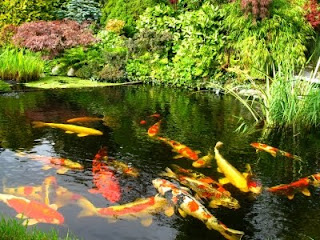
A painting art of Koi fish or Japanese carp , an ornamental domesticated varieties of the common carp that are kept for decorative purposes in outdoor ponds and water gardens. This fish painting clip art also available in wide screen size. It great for desktop wallpaper background. Need some modification for use in powerpoint template ( You can crop it, change level or add new layer with 50% of opacity.

Koi
Koi (鯉?, pronounced [koꜜi]) (English: /ˈkɔɪ/), or more specifically nishikigoi (錦鯉?, [niɕi̥kiꜜɡo.i], literally "brocaded carp"), are ornamental domesticated varieties of the common carp (Cyprinus carpio) that are kept for decorative purposes in outdoor ponds and water gardens. They are also called Japanese carp.
Koi were developed from common carp in Japan in the 1820s, and are still popular there because they are a symbol of love and friendship. A variety of colors and color patterns have since been developed; common colors include white, black, red, yellow, blue, and cream. The most popular category of koi is the Gosanke, which is made up of the Kohaku, Taisho Sanshoku, and Showa Sanshoku varieties.
History
The carp is a large group of fish originally found in Central Europe and Asia. Various carp species were originally domesticated in East Asia, where they were used as food fish. The ability of carp to survive and adapt to many climates and water conditions allowed the domesticated species to be propagated to many new locations including Japan. Natural color mutations of these carp would have occurred across all populations. Carp were first bred for color mutations in China more than a thousand years ago, where selective breeding of the Prussian carp (Carassius gibelio) led to the development of the goldfish.
Carp are known as koi in Japan. Of the various domesticated carp species, the common carp (Cyprinus carpio) is one of the more commonly used in aquaculture. Common carp were first introduced into Japan by way of China between 400 to 600 years ago. Common carp were first bred for color in Japan in the 1820s, initially in the town of Ojiya in the Niigata prefecture on the north eastern coast of Honshu island. By the 20th century, a number of color patterns had been established, most notably the red-and-white Kohaku. The outside world was not aware of the development of color variations in koi until 1914, when the Niigata koi were exhibited in the annual exposition in Tokyo. At that point, interest in koi exploded throughout Japan. The hobby of keeping koi eventually spread worldwide. Koi are now commonly sold in most pet stores, with higher-quality fish available from specialist dealers.
Extensive hybridization between different populations has muddled the historical zoogeography of the common carp. However, scientific consensus is that there are at least two subspecies of the common carp, one from Western Eurasia (Cyprinus carpio carpio) and another from East Asia (Cyprinus carpio haematopterus). One recent study on the mitochondrial DNA of various common carp indicate that koi are of the East Asian subspecies.[5] However another recent study on the mitochondrial DNA of koi have found that koi are descended from multiple lineages of common carp from both Western Eurasian and East Asian varieties. This could be the result of koi being bred from a mix of East Asian and Western Eurasian carp varieties, or koi being bred exclusively from East Asian varieties and being subsequently hybridized with Western Eurasian varieties (the butterfly koi is one known product of such a cross). Which is true has not been resolved.
Etymology
The word 'koi' comes from Japanese, simply meaning "carp." It includes both the dull grey fish and the brightly colored varieties. What are known as 'koi' in English are referred to more specifically as 'nishikigoi' in Japan (literally meaning 'brocaded carp'). In Japanese, 'koi' is a homophone for another word that means 'affection or love'; koi are therefore symbols of love and friendship in Japan. An example of this is given in a short story by Mukoda Kuniko, "Koi-san". Koi tattoos have also become a popular trend in North America.



